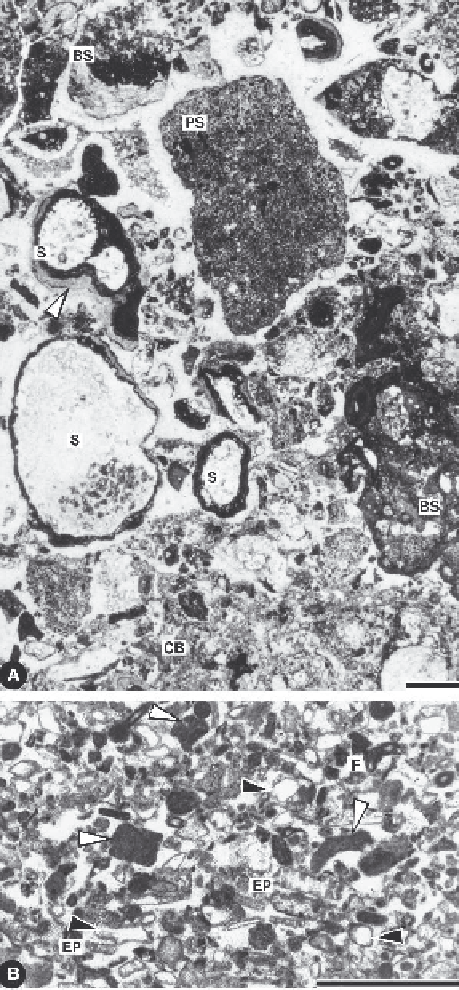Geology Reference
In-Depth Information
Fig. 15.22.
Permian megabreccia and calciturbidites.
A:
The constituent of a megabreccia deposited at the base of
a slope (see Fig. 15.21 for the complex history of the mega-
breccia). The poorly sorted, disorganized breccia consists of
lithoclasts exhibiting different microfacies types and trans-
ported fossils. Most of the clasts are derived from platform-
margin reefs, but some clasts record the erosion of slope
material. Lithoclasts are packstones (PS) and boundstones
(BS). The dark packstone clasts correspond to fine-grained
sediment formed in an upper slope position. Boundstone clasts
consist of
Tubiphytes
, sponges and organic crusts indicating
reef facies. Smaller lithoclasts and fossils bound together by
early lithification form a composite breccia (CB). Isolated
fossils are represented by sclerosponges (S) associated with
biogenic crusts. The arrow points to cement layers overgrow-
ing
Archaeolithoporella
crusts.
B
: Bioclastic fine-grained grainstone consisting of dasyclad
algae (EP:
Epimastopora
), fragments of organic crusts (white
arrows) and shell fragments preserved due to thin micrite
envelopes (black arrows). Minor constituents are benthic fora-
minifera (F). Note weak imbrication and parallel orientation
of grains indicating some current transport. Distal calci-
turbidite. Both samples from the Late Permian of Pietra di
Salomone near Palazzo Adriano, western Sicily, Italy. After
Flügel et al. (1991). Scale is 2 mm for A and B..
stones and grainstones. The latter vary in predominant
grain size and composition. Skeletal grains are derived
from platforms and deposited in thin distal calciturbidite
beds (Fig. 15.22B).
15.7.3.2 Triassic of the Southern Alps:
Allochthonous Slope Sediments
Middle Triassic (Ladinian) and early Late Triassic (Car-
nian) sequences in the Dolomites are excellent ex-
amples of the export of platform and platform-margin
carbonates to slope and basinal environments. The
flanks show well-developed clinostratifications, with
angles of 30° - 40°. These steep angles contrast sig-
nificantly with the horizontal bedding of the platform
interior sediments. The allochthonous material was
transported by various processes, including collapse of
platform margins, sliding, debris and grain flows, tur-
bidity flows, and rockfalls. Progradation generated
large-scale inclined beds (clinoforms) with depositional
slope angles up to 40°. Allochthonous carbonates oc-
cur as isolated blocks (Fig. 15.23), extended mega-
breccias (Fig. 14.17), calciturbidites (Pl. 137) and debris
flows (Pl. 115/2). Foreslope and slope facies types have
been described by Brandner et al. (1991), Harris (1994)
and Russo et al. (1998). Common sediment types are
fine- to coarse-grained limestone breccias and
rudstones, calcarenites (skeletal grainstone, lithoclast
slope reefs and platform carbonates. Subsequent to re-
current erosion, lithified carbonate material was trans-
ported downslope by gravity flow processes and finally
deposited as fillings in depressions and channels in-
cised in basinal sediments adjacent to the base-of-slope.
The largest of the megablocks is the Pietra di Salo-
mone block about 40 km south of Palermo. It is about
200 m long, up to 100 m wide and 30 m high. Textural
types represented in the breccias (Fig. 15.22A) are, in
decreasing order, lithoclastic and lithobioclastic rud-
stones, boundstones with sponges,
Tubiphytes
and bio-
genic crusts (e.g.
Archaeolithoporella
), bioclastic float-

